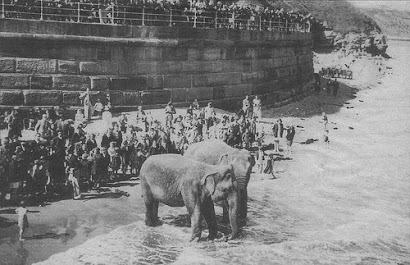The following is taken from an official account made by Whitby's port authority of an incident which occurred on 12th August 1724. It goes some way to show the difficulties Customs Officials had when it came to controlling the smuggling trade in a town where it seemed that everybody was on the side of the smugglers.
The ‘Sarah And Gissell’ had made for the safety of port after the weather had turned against her. The Master, Thomas Robertson of Perth told the Customs officer that his ship was en route from Perth and had come into port wanting provisions. But the ever watchful port authorities soon became suspicious of the ship and it’s Master, according to a sworn statement made by Abram Watkins (a boatman) and William Towers (a tidesman and boatman) the crew of the vessel had lived almost completely of their own provisions the whole time they had been in port, only taking on board a six penny loaf of bread and a small cask of ale. The district Riding Officer further corroborated the port authorities growing testimony by claiming that the ship had previously been anchored off Robin Hood’s Bay selling spirits to the locals.
This was cause enough for the Collector of Customs who immediately sent his rummage men a board the ship, where it was is discovered that the hold was filled with salt in which were buried a large number of barrels containing Brandy. The Master quickly changed his story claiming he had sailed from St. Martin in France and was on his way to Bergen.
The Customs opined that the salt was there to stop the barrels rolling around.‘The salt on board ye ship is in bulk and appears to be made for stowing ye casks in and as ballast and that, when ye vessel first came into port, she appeared to have been lightened above half a foot forward, and by ye stowage of ye Casks it appears that there has been a great part of a whole tier of casks taken forwards’.
The Master of the ‘Sarah And Grissell’ knowing that he had been caught tried to make good his escape and planned to put to sea on the night of the 15th August, the Customs men realising that the ship was been made ready for sea called for re-enforcements, but ‘despite all ye fair means the officers could use, ye Master ordered his men to cast off ye mooring’.
Hacking around with knives in the gloom the officers cut ropes and ratlines to prevent the sails being set, they tried to unship the rudder, but still she moved down the harbour…towed by a local coble skippered by Christopher Hill, recognisable amidst the struggle by his loud voice shouting that he would murder every Customs Officer.
The Master and his mate ‘assaulted and abused’ Mr Selby, the Customs Surveyor, and tore his clothes when he ‘endeavoured to get ye management of ye helm in order to put ye vessel on shore, and at other times when he endeavoured to obstruct their design’.
As the ship moved down the harbour, from St. Ann’s Staith where it had been moored, the customs officers were pelted with large stones from a great number of people on the shore and from cobles running alongside ‘even in such a manner that some of ye officers were obliged to shelter themselves behind ye masts’.
Christopher Hill, ‘that notorious runner of goods whose voice Mr Selby knew very well threatened him and other Officers in a prodigious manner and swearing he would have ye ship to sea over ye next morning’. He went on to have ‘the impudence to abuse Mr Selby and threaten to fight him without the least provocation’.
But the Customs men succeeded in their delaying tactics, the battle royal went on for three hours and she was still not out of the harbour. Abram Watkins, the Customs boatman, tied a rope to another moored vessel, but one of the smugglers slashed it through. Watkins then managed to furl the topsail, but it was immediately unfurled. By now the tide had turned; Watkins managed to cut some of the ropes from the boats towing the vessel out and hauled others onto the ship, during which time he was being assaulted by the Master. Then he bent a small rope to a Cage and dropped it at the stern and was finally able to run the ship aground at Colliers Hope.
After the battle was over a further search of the vessel revealed 13 more casks of Brandy and a parcel of Playing Cards, all of which were removed to the King’s Warehouse. The salt remained on board; the skipper had refused to sell it so the vessel remained in the harbour, so preventing the seizure of the ship whilst prosecutions were being prepared against it’s skipper Thomas Robertson, Henry Mann the mate and Christopher Hill cobleman.
The result of the ship not being cleared of cargo was that the Customs Collector had to stand to the cost of keeping two men on board the vessel. This might look of little importance until it is realised that at the time the Collector only received his dues if the prosecution was successful. Leading to the fact that it might not have always been advisable or even worthwhile actually prosecuting these crimes in the first place.













